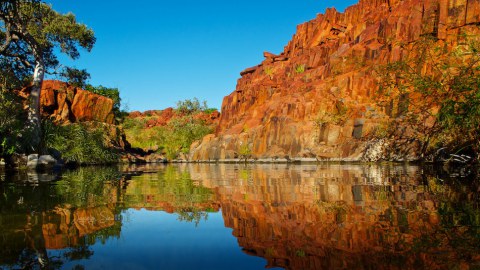Gerry Georgatos - story
Jacquelyn Siew - photo
The West Australian Government has approved the creation of the Murujuga National Park on the Burrup Peninsula, near Karratha, however with a caveat. The National Indigenous Times has recently visited the site, twice in the last couple of weeks and it is a historical preserve that needed to be confirmed. Local Elder Wilfred Hicks is pleased, however much of the surrounds need to be preserved as petroglyphs, rock art and other historical sites need to preserved.
"World Heritage listing needs to be the final outcome to protect our country and its history for our people," said campaigner, descendent of the historical peoples who created the rock art and Elder, Wilfred Hicks.
The Dampier Peninsula is homes to some of the world's oldest rock art, petroglyphs, and along the coast there are millions of rock art. Recently, the University of Western Australia announced a Chair in Rock Art with a focus on the wealth of history along the Dampier coastline.
Western Australian Minister for Environment Bill Marmion recently announced the creation of the state’s 100th National Park in a landmark agreement with Indigenous landowners to protect the ancient Aboriginal rock art.
The establishment of the Murujuga National Park is expected to protect 44 per cent or about 5,000 hectares of the north eastern part of the Burrup Peninsula, located in the Pilbara.
It is the third national park to be created by the present State Government including Dirk Hartog Island and Prince Regent River National Parks.
$24 million has been allocated for capital works including parking, walking trails and visitor information for more than 25 million hectares of national parks, marine parks, State forests, conservations reserves and regional Parks.
The Murujuga Aboriginal Corporation (MAC) will lease the land back to the State in order to create the park. In 2003 the MAC's Native Title agreement ensured the return of their country to them. With the land leased to the State Government, the Department of Indigenous Affairs will outline the management operations for the park during the next ten years.
According to Mr Marmion it is the first joint management agreement to be reached under the amendments made to the Conservation and Land Management Act in March 2012.
“The new Murujuga National Park will provide for the protection of the area’s nationally important conservation and cultural values and is an excellent example of a partnership that balances the protection of ancient and living heritage with sustainable use of the region’s natural resources,” Mr said Mr Marmion.
The WA Greens applauded the establishment of the park, however Greens MLA Robin Chapple supported Elder Hicks and said it is only one small step towards World Heritage listing of the Burrup.
"It is of concern however that the area being set aside is only a small portion of the Burrup Peninsula, leaving some 6,400 hectares unprotected and available for industrial development."
"The original proposal in 1990 was for the declaration of the Dampier Archipelago National Park that would have included the Burrup and all 42 adjacent islands. The Murujuga National Park falls far short of that," said Mr Chapple.
"The Premier (Colin Barnett) first made a commitment to protecting the area in 2006, when he acknowledged the age and scale of the rock carvings and referred to the Burrup as 'probably the most important heritage site in Australia' and 'up there with Uluru'."
The petroglyphs of the Burrup are range from 200 to 30,000 years, making most of them many times older than the pyramids.
"We have a responsibility to the rest of the world to protect and preserve them," said Mr Chapple.
"That includes protecting them from the corrosive effects of carbon dioxide, sulphur and nitrogen emissions from the nearby liquefied natural gas industry and the fertilizer factory. If we don't act immediately we risk losing them altogether."
"It is also critical that visitor access and the activities of sightseers are managed to avoid the type of damage that occurs all too often on the Burrup. Just last year vandals scraped graffiti into rocks that also displayed an 8,000 year old petroglyph."
Elder Hicks, Burrup peninsula campaigners and Mr Chapple will continue the campaign for World Heritage listing for this Burrup peninsula.
LINKS:
http://www.nit.com.au/opinion/1538-wong-goo-tt-oo-elders-launch-global-c...
Wilfred Hicks is a Traditional Owner of Western Australia's world famous Murujuga rock art, and with the onerous responsibility for the millions of petroglyphs that are the rich litany of the region, the Wong-goo-tt-oo Elder is fighting to save them for his peoples and their descendants
http://indymedia.org.au/2012/04/23/alongside-the-yaburara-and-won-gg-tt-...
According to the National Trust of Australia (WA) Dampier Archipelago contains the largest concentration of rock art in the world, estimated at perhaps a million petroglyphs. The art is extraordinary in its range and diversity. Associated with the art is a rich archaeological record, including camp sites, quarries, shell middens and stone features. Many motifs and some stone features are connected to the beliefs and ceremonial practices of Aboriginal people in the Pilbara region today. The entire Archipelago is a continuous cultural landscape providing a detailed record of both sacred and secular life reaching from the present back into the past, perhaps to the first settlement of Australia.


Comments
Our self-interested state government occasionally do right
It may well be a case of 'too little, too late', but at least our self-interested state government can occasionally do the right thing!